#gelug
Text

Not yet blocked, but a present for a friend of mine who is a Gelug nun.
12 notes
·
View notes
Text
The internet is such a wonderful technology, with a few clicks and keystrokes I can hear Dharma teachings given years ago in Malaysia by a dead Mongolian-American lama who trained in India under Tibetan masters, all from the comfort of my own home in Guatemala. Even though it's the Dharma Decline Age, we are blessed with many opportunities to encounter the teachings that we would have never had mere decades ago.
6 notes
·
View notes
Photo
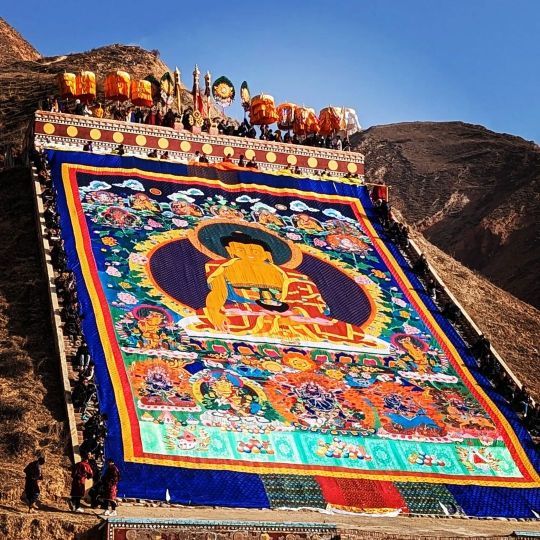
Tanning #Buddha, #Gelug #Tibetan, festival for #Tsongkhapa, #Regon area, #Qinghai province 格魯派,曬佛,宗喀巴節日,熱貢青海 https://www.instagram.com/p/Cn4MjfnymS_/?igshid=NGJjMDIxMWI=
2 notes
·
View notes
Text
Book of the Day - The Art of Happiness
Today’s Book of the Day is The Art of Happiness, written by His Holiness The Dalai Lama in 1998 and published by Riverhead.
Jetsun Jamphel Ngawang Lobsang Yeshe Tenzin Gyatso (born Lhamo Döndrub), the 14th Dalai Lama, is the leader of Tibetan Buddhism since 1950 and also the leader of the Tibetan Government in Exile after the Chinese invasion of Tibet in 1959, and a Nobel Peace Prize Laureate…
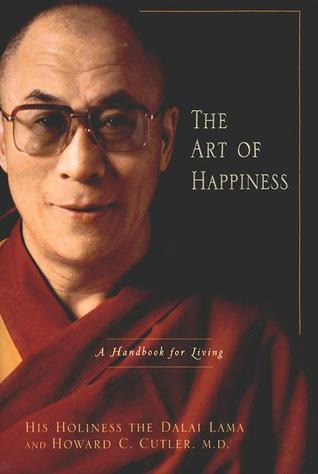
View On WordPress
#anger#Anxiety#behaviours#beliefs#book recommendation#book review#bookstagram#booktok#Buddhism#Buddhist practice#Dalai lama#fear#Free Tibet#Gelug Buddhism#Happiness#meditation#mindfulness#motivations#Nobel Peace Prize#Nobel Peace Prize Laureate#peaceful spirit#perspective#Psychology#Raffaello Palandri#Tenzin Gyatso#Tibet#Tibetan Buddhism#Tibetan Government in Exile
2 notes
·
View notes
Text
It really is a shame that there's no online Tendai sangha that meets at a time that is convenient for me or even just has a presence somewhere less ephemeral than video calls because the idea of an integrated Precepts + Meditation + Pure Land + Vajrayana approach held together by the glue of the Lotus Sutra seems ideal for me but as it is I'm just left to cobble my own practice out of my forays into the disparate schools of Chinese Pure Land, Gelug, and (to my great surprise) Nichiren.
#not that I think my practice is bad mind y'all#the gelug approach to samatha and vipassana suits me I think#I am excited to begin the refuge ngondro practice with Sravasti Abbey#I also appreciate having the low commitment fallback of Pure Land practice even if I shy away from it at times#and tbh I have been warming up to Nichiren-descended Lotus Sutra traditions the more I give them a shot#even if I'm not too fond of the historical person of Nichiren#buddhism#oh btw watch me add yet anothe thing to that list not too soon afterwards
0 notes
Note
hello and happy new year! i wanted to ask about your resources for learning about buddhism. i enjoy your philosophical and spiritual thoughts and am hoping to find more ways to learn about or get into it, if you have any to share!
your local sangha and dharma leader!
bare essentials: buddhanet dot net!
personal rec: studybuddhism dot com! (tibetan focus, love alex berzin!)
library; WIP, buddhist canon: 84000!
library; theravada suttas (tipitaka): dhammatalks dot org!*
(i lack other centralized theravada (predominantly south- and southeast-asian) libraries! i scavenged!)
essential zen practice: thích nhất hạnh!
essential tibetan: fpmt dot org! (lama yeshe and lama zopa rinpoche are prolific gelug authors!)
(i only rec TNH and zen because theyre on-the-shelf so to speak, and i dont recall any centralized mahayana libraries ive used for my scavenging!)
online sangha: dharmawheel dot com for mahayana, dhammawheel dot com for theravada!
online sangha: theres a discord server somewhere out there if i can find it comprised a spectrum between laymen and experts! lmk if you want me to look!
when researching i rec starting from scholastic cohorts that instigate schisms! then tracing their old schools lineage!
i hope you see this and dont just follow my reblog blog! <3
*previous version listed accesstoinsight dot com, which a dear friend of mine (@unthinkingclunk) corrected as follows:
FYI accesstoinsight is largely "dead"-- it's not being updated anymore, you can see this link for details:
https://www.dhammatalks.org/suttas/ati.html
But in short you'll see many links to accesstoinsight all over but those pages now largely point out at the top of the page (for any specific sutta) that the current site is dhammatalks.org (which is the base site of the link I posted)
14 notes
·
View notes
Text

We are initiating a new course on The Voice of the Silence, an ancient manual of esoteric instruction. This work was translated by the eminent Helena Petrovna Blavatsky, founder of the Theosophical Society, whose scholarly and spiritual achievements cannot be easily estimated. This brief mystical text is a collection of fragments from The Book of the Golden Precepts, an obscure and rich scripture from which The Secret Doctrine was inspired.
The Voice of the Silence was not fully translated, since it would have required Blavatsky many years just to organize her documents, let alone translate the work in its totality. She also mentioned that much of this scripture is too sacred and profound to be understood by her students. This is a powerful statement, one that should not be overlooked. This guide, she said, is for serious practitioners who are awakening consciousness.
Although The Voice of the Silence is brief, it is dense, and therefore difficult to interpret. As with any deep work, it requires an awakening consciousness to decipher, apply, and realize. Despite the brevity of this work, it synthesizes the entire path to liberation. This is no small feat.
The origins and translation of this work has often been contested and disputed. However, the Panchen Lama affirmed its authenticity. In case you do not know, the Panchen Lama is second in command to the Dalai Lama within the Gelug school of Tibetan Buddhism. As he stated in 1925:
It is the “only true exposition in English of the Heart Doctrine of the Mahayana and its noble ideal of self-sacrifice for humanity.” ―The Panchen Lama (1925)
#gnosis#gnosticism#spirituality#meditation#awakening#consciousness#gnostic#spiritual#chicago gnosis#samael aun weor#gnostic academy of chicago#kabbalah#alchemy#psychology#spiritual psychology#mysticism#voice of the silence#how to meditate#meditation podcasts#spiritual podcasts#helena blavatsky#theosophy#tibetan buddhism#buddhism#christianity#gnostic christianity#esoteric christianity#bodhisattva#mahayana#tantra yoga
37 notes
·
View notes
Text
ok little bit of a silly post td
I was doing a little bit of research about each of the cultures the 4 nations are based on for some oc lore (shh) and I started looking into Tibetan Buddhism and Tibetan culture as a whole and. okay so you all know about the Dalai Lama right? if not, it’s basically the name Tibetans gave the spiritual leader of the Gelug (“red hat” school of Tibetan Buddhism) okay so. there’s a 14th, incumbent Dalai Lama. he lives in exile as a refugee in India.
do you know what this guy’s name is. take a wild guess.
his name is tenzin gyatso. that is his full name.
dear atla writers,
you are so fucking funny. I love you dearly.
14 notes
·
View notes
Text

Tibetan Buddhist leader the Dalai Lama, wearing a yellow ceremonial hat of the Gelug school, performs a ritual during a sermon on the 15th day of the first Tibetan month at the Tsuglakhang temple in Dharamshala, India, Saturday, Feb. 24, 2024. (AP Photo/Ashwini Bhatia)
5 notes
·
View notes
Text
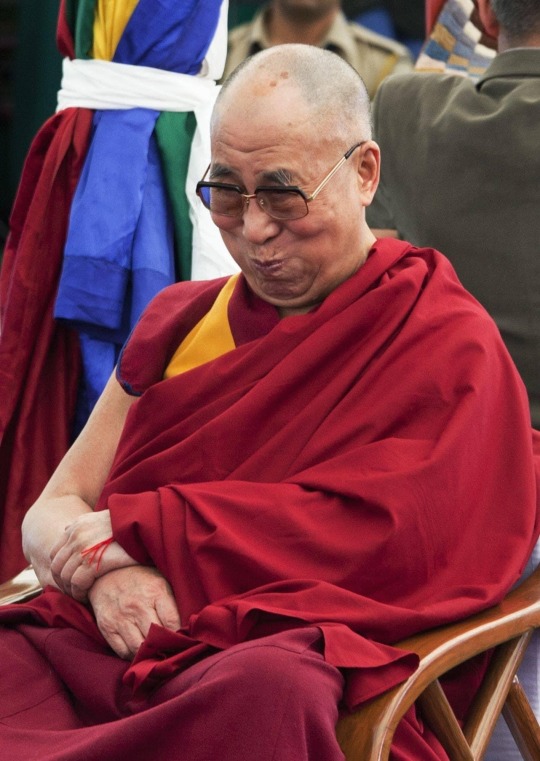
THE 14TH. DALAI LAMA
Many people who approach the practice of Buddhism are willing to sacrifice one or two hours of their day in order to perform some ritual practice or engage in meditation. Time is relatively easy to give up, even though their life may be very busy. But, they are not willing to change anything of their personality - they are not willing to forgo anything of their negative character. With this type of approach to Buddhism, it hardly matters how much meditation we do, our practice remains merely a hobby or a sport. It does not touch our lives. In order actually to overcome our problems, we have to be willing to change - namely to change our personality. We need to renounce and rid ourselves of those negative aspects of it that are causing us so much trouble.
***The Gelug/Kagyu Tradition of Mahamudra
45 notes
·
View notes
Text

The Significance and Practices of Ngondro in Tibetan Buddhism
The term "ngondro" in Tibetan Buddhism, often translated as "preliminary practices," holds deeper connotations of preparation rather than mere preliminaries. Just as one prepares for a journey, ngondro practices prepare practitioners for the spiritual journey, essential for sustaining progress in the path of enlightenment.
The Purpose of Ngondro:
Ngondro practices serve to build positive energy and diminish negative tendencies accumulated over lifetimes. By engaging in hundreds of thousands of repetitions, practitioners gradually rewire their minds, paving the way for transformative growth.
Approaches to Ngondro:
There are two primary approaches to Ngondro: initiation at the start of Buddhist practice or incorporation along the way to enhance both sutra and tantra practices. While the former tests commitment and builds discipline, the latter integrates practices into the ongoing spiritual journey, emphasizing the importance of avoiding mechanical repetition and cultivating sincere motivation.
Illustrative Examples:
1. Milarepa's Journey: Milarepa, the renowned Kagyu yogi, underwent rigorous preliminary practices under his teacher Marpa's guidance, demonstrating the transformative power of sincere motivation in overcoming past negative actions.
2. Tsongkhapa's Method: Tsongkhapa, the founder of the Gelug tradition, exemplified the integration of Ngondro practices into advanced stages of study and practice. Despite his scholarly prowess, Tsongkhapa embarked on extensive Ngondro retreats under the guidance of Manjushri, emphasizing the need to cultivate positive force and rid oneself of negative potential for deeper understanding.
Personal Reflections:
Drawing from personal experience, the importance of periodic retreats or engagements in teaching and sharing Buddhist wisdom, akin to "bodhichitta retreats," is highlighted. Additionally, the practice of mantra repetition with visualizations serves as a means to clarify the mind and overcome obstacles in writing or translation endeavors.
Conclusion:
Ngondro practices in Tibetan Buddhism serve as vital preparations for the spiritual journey, offering pathways to cultivate positive energy, overcome negative tendencies, and deepen one's understanding of the teachings. Whether undertaken at the outset or integrated along the way, Ngondro practices offer profound opportunities for growth and transformation on the path to enlightenment.
#buddha#buddhist#buddhism#dharma#sangha#mahayana#zen#milarepa#tibetan buddhism#thich nhat hanh#dzogchen#dzambala#Padmasambhava#Guru Rinpoche
2 notes
·
View notes
Text
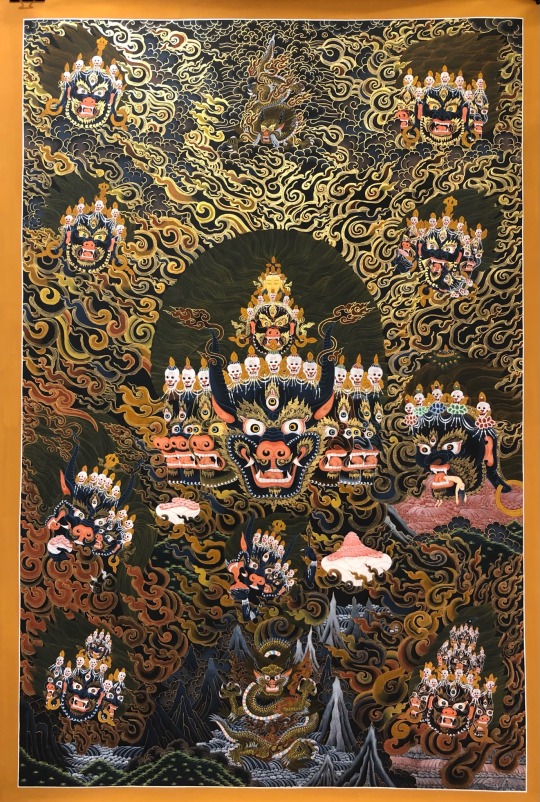
Yamantaka (Slayer of Yama, the Lord of Death).
.
.
.
.
.
#vajrabhairava #yamantaka #lordofdeath #manjushri #bodhisattva #wisdom #wrath #thangka #thankapainting #lamathankapaintingschool #dharma #vajrayana #buddhism #sacred #art #himalayan #traditional #tantra #buffalohead #himalayanart #gelug #sadhana #visualization #enlightened #meditation #dhamma #mindfullness
15 notes
·
View notes
Text
Intro Post
Amituofo!
Welcome to my online practice journal/Dharma study blog! My Dharma name is 嘉安 (Jiā'ān) and just last year I formally took the Three Refuges and Five Precepts ceremony under Master Renshan, the abbot of Zhenning Temple in Qingtian, China.
I've been an on-again-and-off-again Buddhist for the majority of my adult life but I think I've finally found a place in my practice where I'm comfortable enough to commit call myself a full convert. I have some experience under the Theravada and Soto Zen lineages but nowadays I mostly practice the Pure Land path as taught by Master Renshan's student Jiawen. Although I do dip my toes ocassionally into the Gelug school's presentation of the Dharma.
My hope is that by means of this blog I can refine my understanding of the Dharma and help others along the path through dialogue and the sharing of Dharma materials.
May all sentient beings be reborn together in the Western Pure Land of Amitabha Buddha! 🙏📿
2 notes
·
View notes
Photo
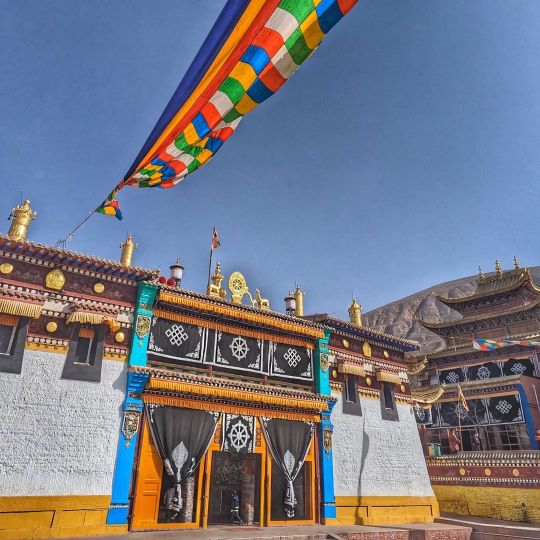
Tanning #Buddha, #Gelug #Tibetan, festival for #Tsongkhapa, #Regon area, #Qinghai province 格魯派,曬佛,宗喀巴節日,熱貢青海 https://www.instagram.com/p/Cn4MZgVysOs/?igshid=NGJjMDIxMWI=
0 notes
Text
Book of the Day - The Leader's Way
Today’s Book of the Day is The Leader’s Way, written by His Holiness the Dalai Lama and Laurens van den Muyzenberg in 2011 and published by Nicholas Brealey Publishing.
His Holiness the Dalai Lama is the highest spiritual leader and head of Tibet and lives in exile as a refugee in India after the Chinese invasion of his motherland in 1959. He is also the leader and a monk of the Gelug…

View On WordPress
#awareness#Book#book recommendation#book review#Buddhism#buddhist wisdom#Business#compassion#Dalai lama#Gelug Buddhism#His Holiness The Dalai Lama#inspiration#leadership#Management#meditation#mindfulness#Motivation#purpose#Raffaello Palandri#Raffaello Palandri Buddhist Master
4 notes
·
View notes
Text
Lingshan Hermit: We discuss the clouds in the sky, the tea in our cups; we refrain from worldly chatter.
Today, almost every Buddhist seems to be advocating the Rimé philosophy, which has nearly become a diplomatically correct term. This isn't just within Buddhism; politicians globally are also striving hard to showcase their embracement of Rimé sentiments. You seldom hear any religious or political leaders (except Trump) saying, "We only consider our own sect or country, and never others." But in reality, their actions contradict their words. Even within Buddhists, those who genuinely embody the spirit of Rimé are extremely rare. Many Buddhists are not even aware of what Rimé truly signifies.
Many people ask me what Rimé is. Rimé is an attitude; it means all Buddhist teachings, irrespective of Tibetan or Han traditions, originate from Buddha. They appear so distinct or even contradictory because they are spoken to different audiences, or have been shaped by various traditions and styles across different regions. Not everyone requires the same teachings, nor should all teachings bear the same facade across regions. You may not understand for whom a particular teaching is intended, but it will undoubtedly prove beneficial for some practitioners. Therefore, we must respect all teachings and traditions, for they are all Buddha's teachings. Each lineage has proven its significance; countless enlightened beings have emerged from each lineage. It's akin to a visit to a pharmacy: we may only need aspirin, but that doesn't mean all other medicines should be discarded, or that every patient, be it an AIDS or lupus patient, should take aspirin. Nor should one think that they must take every medicine simultaneously. All medicines demand respect; you might only need one kind, but many others need different ones to treat their conditions.
It's said that when Jamyang Khyentse Wangpo was giving teachings, if he was teaching the Gelug school's Dharma, he would put on the Gelug hat and follow the Gelug tradition to show respect for the Gelug school.
Rimé does not imply everyone should celebrate together, forgetting their differences. Rimé is a sentiment only very advanced practitioners possess. Although everyone says they should be non-sectarian, it does not mean everyone who says so truly embodies it. In fact, it's quite the opposite; most people are not Rimé at all; they are merely pretending. But the issue is, you can't fake Rimé; it's the result of spiritual practice. The more advanced your practice, the more Rimé your attitude. If you are honest with yourself, you should realize you don't care about the survival of other sects. You don't see all teachings as equal. Even if others are eloquent, you don't think their sect is better than yours. Among Buddhists, everyone is talking about Rimé, but Rimé is increasingly becoming a politically correct diplomatic term. Buddhists speaking of Rimé increasingly resembles politicians lying for political correctness. This is precisely my concern.
You know, I've always discouraged gathering people from different sects together—those who like doing this might have had a stroke—even if everyone is a Buddhist, there will be a lot of unpleasantness resulting from it. Maybe you won't see Buddhists shooting at each other with AK47s due to displeasure. But the problems triggered by various emotions aren't few. Why bother? Therefore, I strongly advise against people from different sects becoming friends or getting too close—unless they never discuss sectarian practices, unless they are enlightened beings. In fact, I've had friends from other sects, and when we were together, we only talked about things unrelated to Buddhism. We would discuss the clouds in the sky, the tea in our cups; we didn't talk about sectarian matters. Our sectarian views are very different; only a fool would try to explore these.
But you should know, not every Buddhist knows how to get along with people from different sects. When most people are with others from different sects, they actually do one thing—try to prove that their sect is better or promote their sect. This is bound to invite resentment. More often than not, it leads to a counterattack.
In early 2015, many Europeans naively thought they could live with Muslim refugees. I don't know if they still think the same. Let alone getting Christians and Muslims to coexist peacefully. Even Buddhists, who are generally considered very mild, would generate a lot of friction if they lived together, even if they are from the same sect, even if they share the same teacher. And what about different sects, different civilizations? We are all humans, and we all have human flaws.
For Buddhists, staying where they should be and practicing their Dharma is enough; there really isn't much need to get too close to each other. Based on my limited observations, most inter-Buddhist socializations end up in disagreements. Because everyone thinks they are right, everyone thinks the other should listen to them, everyone thinks the other is insignificant, and everyone thinks their Dharma is better—because it is "theirs." This is exactly the attitude Rimé aims to eliminate—we favor our own Dharma, our own sect, because we love ourselves. Therefore, keeping a moderate distance from each other is a beneficial attitude for both parties.
Written by Lingshan Hermit on July 24, 2016.
Copyright Notice:All copyrights of Ling Shan Hermit's articles in Simplified and Traditional Chinese, English, and other languages belong to the natural person who owns "Ling Shan Hermit". Please respect copyright. Publishers, media, or individuals (including but not limited to internet media, websites, personal spaces, Weibo, WeChat public accounts, print media) must obtain authorization from Ling Shan Hermit before use. No modifications to the articles are allowed (including: author's name, title, main text content, and punctuation marks). We reserve all legal rights.
灵山居士:我们会谈天上的云,杯里的茶,我们不谈论见地
5 notes
·
View notes